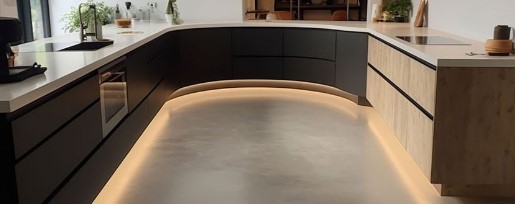 Add My Company
Add My Company
MICROCEMENT FLOOR PROS AND CONS

WHY CHOOSE MICROCEMENT FLOORING?
Microcement flooring has been steadily rising in popularity across the UK over the past few years. With this surge in interest, DirectStone clients are eager to know how it measures up against polished concrete flooring. As experienced installers of both microcement and polished concrete flooring the DirectStone team has taken it upon themselves to consider the pros and cons of a microcement floor.
WHAT IS A MICROCEMENT FLOOR?
Microcement is a type of cementitious coating that’s used as a decorative finish for floors, and walls. It’s made up of a blend of cement, fine aggregates, polymers, and additives that create a thin, durable layer. Microcement coating is 2 to 3 millimetres in depth when complete; it’s made up of multiple thin layers which create a seamless and smooth surface.
Applying microcement involves thorough surface preparation, followed by the application of a primer and several coats of microcement. Each layer is carefully applied and hand-trowelled to achieve a smooth and flawless finish. DirectStone applies Forcrete microcement which is fairly unique in having integral waterproofing at every layer.
WHAT ARE THE PROS OF A MICROCEMENT FLOOR?
The DirectStone team is not easy to impress, but we are happy to unreservedly recommend this product to our customers. And here are 6 reasons why:
- Seamless Flooring. Microcement is applied in thin layers, allowing for a seamless finish without any grout lines or joints. This makes kitchen or bathroom floors easier to clean and maintain. It’s also a distinct advantage to heat transmission if you’re planning on installing underfloor heating.
- Durability. Durable and resistant to wear and tear, microcement is designed to withstand heavy foot traffic, making it suitable for both residential and commercial spaces. With ongoing maintenance, microcement flooring will last for many years.
- A Lightweight Flooring Finish. Microcement is applied as a thin coating; typically 2 – 3 millimetres in depth. Its lightweight nature makes it suitable for applications where weight might be a concern, such as on existing floors or walls, or upper storeys.
- Versatility. Microcement can be applied to numerous surfaces, such as concrete, tiles, wood, and even vertical surfaces like walls and stairs. It’s this versatility that makes it an ideal choice for renovations and refurbishing projects.
- Waterproof and easy to clean. Forcrete microcement is waterproof upon application. The sealant we add helps to increase its resistance to stains and spills. It is easy to clean and maintain, requiring only regular sweeping and occasional mopping with a mild detergent.
- Colour Your Floors. Microcement comes in a fantastic range of colours. DirectStone colour matches RAL, Pantone, NCS and many of the high-end paint manufacturers’ colours. We will also adjust the shade and intensity of the colour to match your interior colour scheme.
WHAT ARE THE PROBLEMS WITH MICROCEMENT?
We don’t believe in hiding issues with our products; our customers need to know whether the flooring finish they choose is right aesthetically, and practically for their requirements. The problems presented by a microcement floor are few, we’re glad to report, and easy to overcome:
- Professional Installers Required. Application of microcement flooring involves meticulous preparation and hand-trowelling application techniques to achieve the optimum finish. DIY installation is not recommended.
- Hairline Cracks. Though durable, microcement may develop hairline cracks over time, especially if the underlying surface experiences movement or shifts. These cracks can be repaired, but they may require periodic maintenance.
- Installation Times. Dependent on the size of the floor to be covered, and the complexity of the project, microcement installation can take between 4-7 days. Working with professional installers ensures the speediest installation times.
- Limited Insulation. A microcement floor may feel cold underfoot, especially during the winter. However, this can be resolved by installing underfloor heating which guarantees warm feet and a cosy living space.
WHICH IS BETTER, POLISHED CONCRETE OR A MICROCEMENT FLOOR?
Both flooring finishes offer a superb look and style to floors. DirectStone flooring specialists are even able to reproduce the look and feel of polished concrete flooring using microcement – the best of both worlds, you might say! Microcement offers a greater choice of colours, but it doesn’t provide the organic depth of hue that polished concrete can provide.
The greatest difference between the two floors is the weight of the flooring itself, and the versatility this brings in its application. If you want a flooring that can be styled over existing tiles or floorboards, microcement is the ideal choice.
ABOUT DIRECTSTONE
We are a long-established family-run business with a reputation for hand-finished, diamond-polished concrete flooring as well as microcement floor and wall installations in both commercial and residential buildings. We are delighted to add microcement to our range of flooring options for home improvement projects, renovations, refurbishments, or new builds.
Thinking about a microcement floor? if you would like to find out more about microcement floors or walls, get in touch with us today on 01525 863920. We are always happy to provide a no obligation quote.
For more information on MICROCEMENT FLOOR PROS AND CONS talk to DirectStone Ltd



